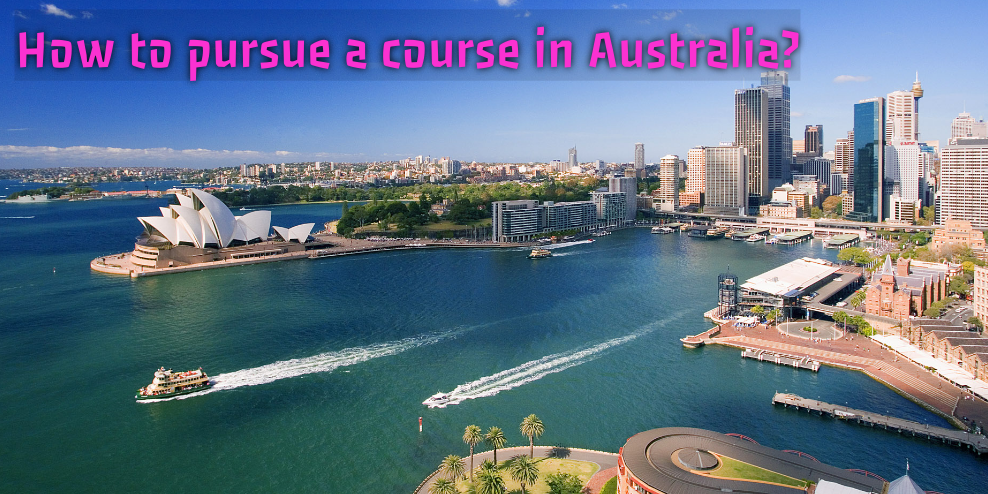How to pursue a course in Australia?
Author : Lavanya Posted On : Tuesday, 18th April 2017
One of the major destinations for Indian students studying abroad is Australia which offers 22,000 courses across 1,100 institutes. Choosing to study in Australia is just one step in a long process to actually get there.
For those who want to pursue their dream courses in this country, here are some steps you can follow:
1. Pick a course:
There were 51,809 Indian students studying in Australia as on March 2016. Among the most popular courses offered, Business and Finance, Hospitality and STEM receive the maximum number of applicants.
The business and finance courses popularly pursued include bachelors in Business, Business Administration, International Business, Aviation Management, Business Economics, Business and Commerce, Business and Information System, Exercise and Sport Science, Business- Information Technology, Accounting and Finance, Finance/Industrial Banking and Actuarial Studies and Commerce.
In hospitality, you can pick between bachelors in Hospitality Management, Business-Hospitality and Tourism and International Tourism and Hotel Management.
The most popular STEM courses are bachelor of Biomedical Science, Biotechnology, Mechanical Engineering Honours, Civil Engineering Honours, Games Development, Nursing, Microbiology and Social work.
Lastly, you can choose among the undergraduate diploma courses in Accounting, Automotive Management, Design Visual Communication, Hotel Management, Basic Cuisine and Basic Pastry, Fitness, Aviation and Automotive Management.
2. Pick a University:
Search for the universities in Australia that offer the courses of your choice. According to the World University Ranking by Times Higher Education, the best universities in Australia are University of Melbourne, Australian National University, University of Sydney, University of Queensland and Monash University.
3. Check your eligibility:
How do you find out if you are eligible for the course. The eligibility and requirements vary from one university to the other and from one course to another. There are, however, some common prerequisites when you apply to a university.
This includes the English language proficiency test like IELTS, TOEFL, PTE and CAE the minimum score for which depends on the university. Some business schools tend to accept students based on their score in the Graduate Management Admissions Test (GMAT) while for other courses, there may be specific aptitude tests which you will need to pass.
Additionally, you will be also judged based on your academic scores. While most universities ask for a score of at least 60 per cent, others require 80 per cent. Even with a low percentage, there are still ways to get into a university.
4. Apply!
Now that you are eligible for the course, you can go ahead and apply for it. This can either be done through a registered education agent or directly through the university’s website. If the university accepts your application, you will receive a Letter of Offer and an electronic Confirmation of Enrolment (eCoE). Once these confirmations are made, you can apply for your student visa.
To be granted the Student Visa, the Australian Government has listed out the following eligibility criteria:
– Applicants must take English language proficiency test such as IELTS, TOEFL, Pearson Test of English (PTE) Academic, and Cambridge Advanced English (CAE).
– Applicants should have sufficient finance reflected on her/his account, enough to cover travel expense (AUD1,000), Course fee and 12 months’ living cost (i.e. student/guardian AUD 19,830; partner/spouse AUD 6,940; child AUD 2,970).
– Applicants are obliged to purchase Overseas Student Health Cover (OSHC).
Remember, if you are planning to study in Australia, you will need to start preparing for it at least 9 to 12 months prior to the university intake deadline. In that time, you can take the standard tests required to get you there. Do not wait for the application deadline as Visa approval takes up to 6 to 12 weeks, and there are times when it can get late leading to your application getting deferred.
5. Research:
If you are going to study in Australia, you should know the rules and the way of life there. Visit the websites of “Indians in Australia” (www.hcindia-au.org) and the website of the Australian High Commission/Consulates General in India (www.india.embassy.gov.au) to learn about the Indian community in Australia, Guidelines for studying in Australia and other useful information.
To learn about the other international students studying in the country, go to the “Study in Australia” website (studyinaustralia.gov.au). Here, you will also find information about scholarships and funds.
If you are confused about your application for student visa, General Skilled Migration programme and Permanent Residency in Australia, you can find detailed information about the same from the Department of Immigration and Border Protection (www.immi.gov.au).
You can also research on what you wish to do after the completion of the course. Australia offers a high remuneration to its fresh graduates. Additionally, its federal minimum wage is also among the highest in the world. The average starting salary for graduate (bachelors) students in their first full-time employment is AUD 54,000, for STEM graduates is AUD 80,000, for Economics, Business, and Hospitality graduates is AUD 50,000 to AUD 53,000 and Finance and Accounting graduates earn up to AUD 50,000.
Image Source : http://cdn.pcwallart.com/images/australia-wallpaper-3.jpg
Post Your Comments for this Blog Post
Blogs
South India spends most on higher education
How to pass exams when there is no time to revise?
Research proven tips for increasing childs IQ
The Ultimate Student Guide For Surving Final Exams
How to crack UPSC Civil Services interview round?
Smart Tips for Writing Power Packed Resume